Understanding Cat Food Labels–Part 1
Cat Food Labels–What’s In Your Cat’s Food?
Have you ever looked at the label on your cat’s food? These days it requires not only a magnifying glass but a dictionary! All kidding aside, I highly recommend you spend a few minutes analyzing what’s in your cat’s food. I was in a Facebook conversation about a cat with health issues this week whose owner had used some holistic ways to treat them. While this is fantastic, in many ways it’s like putting a bandaid on the problem. Without treating the cause the symptoms will continue to return. Many cat health issues can be addressed simply by making dietary changes; therefore, understanding cat food labels is a great first step.
Guaranteed Analysis
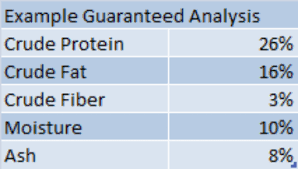
Photo credit slimdoggy.com
When you look at the label you’ll find the guaranteed analysis. This breaks down the percentage of proteins, fats, moisture, and in some cases, minerals, vitamins, and other ingredients. Pet food manufacturers are NOT required to list the amount of carbohydrates in the food, so it’s unlikely you’ll see this on the label. Carbs will include rice, potatoes, beans, peas, lentils, corn products, wheat products, and quinoa, just to name a few. Because cats are carnivores their diet should be meat-based, and the percentage of carbohydrate should ideally be no more than 7-8%. Here’s a quick formula to help you determine how to calculate the amount of carbs in the food:
100 – % protein – % fat – % moisture – % ash (if not listed, assume 6%)
= % carbs
This can be very shocking, especially if you feed your cat a “grain-free” diet. Grain-free doesn’t mean carb-free. To learn more about that topic check out this article. A cat’s diet should also be very high in moisture in order to make sure the kidneys are not overworked. Dry food diets have very little moisture at all. With the number of cats diagnosed with kidney disease it’s not surprising when you consider how many eat kibble.
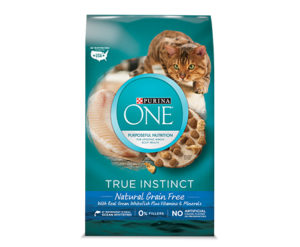
Let’s take an example of Purina One True Instinct Natural Grain Free With Real Ocean Whitefish Plus Vitamins & Minerals. The label says the protein is 35% and fats are 14%. Ash is not listed, so we’ll assume 6%. Insert these values into our formula and you find:
100% – 35% – 14% -6% = 45% carbohydrate
Are you shocked? For a grain free product it sure has a lot of carbs! Grains and carbs promote inflammation and put a lot of stress on the pancreas because a cat’s pancreas isn’t able to break the down a high amount of carbs. Over time your cat may develop diseases like pancreatitis, lymphoma, IBD, diabetes and cancer.
Diving in to Meat Meal, Meat By-products, Meat & Soy
As I mentioned earlier, cats are carnivores, and the primary ingredient in their diet should be meat. Some manufacturers cut corners on nutrition and include things like meat meal and meat by-products instead of using real, high quality meat. Let’s take a closer look.
Not all meat is created equal when it comes to pet food. High quality proteins are easily digested, broken down at the cellular level, and used by the body (bioavailable). If you’re not careful you could be offering your cat a meat product that’s sourced from factory farms (CAFO), which are often fed a GMO diet, and injected with hormones and antibiotics. Furthermore, they are raised in an inhumane, unnatural environment. This food is much cheaper which is what appeals to the larger pet food manufacturers who are profit-centered.
Meat Meal
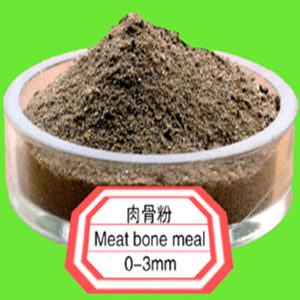
Meat bone meal
What exactly is meat meal? As defined by AAFCO, “Meat Meal consists of the rendered product from mammal tissues, exclusive of blood, hair, hoof, horn, hide trimmings, manure, stomach and rumen contents except in such amounts as may occur unavoidably in good processing practices.” It is still legal for pet food manufactures to source these products from dead, dying, diseased, or disabled animals. These ingredients are cooked at high temperatures, and the water is removed, resulting in a powdered meal. Most meal meals are used in dry foods. You may also see bone meal on the label which is made the same way.
Meat By-products
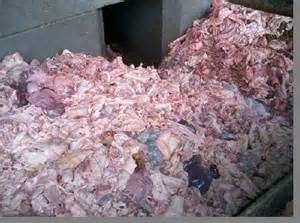
Meat by products
Meat by-products are essentially leftover wastes from human food consumption, and are categorized as “named” or “un-named.” Let’s look at the example of chicken by-products.
As defined by AAFCO, the Association of American Feed Control Officials, the organization that creates guidelines for livestock feed and pet food, “Chicken by-product meal consists of the ground, rendered, clean parts of the carcass of slaughtered chicken, such as necks, feet, undeveloped eggs and intestines, exclusive of feathers, except in such amounts as might occur unavoidable in good processing practice.” Un-named by-products include “meat by-products”. The AAFCO definition, “Meat by-products consist of the non-rendered, clean parts, other than meat, derived from slaughtered mammals. It includes, but is not limited to, lungs, spleen, kidneys, brain, livers, blood, bone, partially de-fatted low-temperature fatty tissue and stomachs and intestines freed of their contents. It does not include hair, horns, teeth and hooves.” By-products are not even classified as meat products, and are commonly sourced from “dead, dying, diseased, or disabled” animals.
Meat products
Ideally the meat ingredients should be from muscle meat (not organs or broth) and the label would describe them as chicken, beef, turkey, pork, salmon, etc. They should be the first ingredients.
Soy products
If you find soy products on the food label be warned. This is another cheap (plant) protein source that carnivores were never meant to eat and it’s a common allergen source. Most of the soy produced in the US (greater than 89%) is genetically modified (GMO) which should be avoided at all costs. Furthermore, GMO foods are not natural nor safe for human or pet consumption. Common soy ingredients would include soybeans, soybean oil, soy protein isolate, soy flour and soybean meal.
Fillers
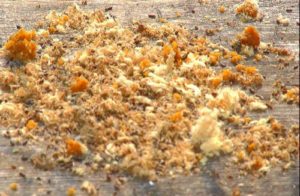
Powdered cellulose
If you look closely at the label you may also come across things like rice hulls, brewer’s rice, powdered cellulose, dried beet pulp, soybean hulls, All these products are basically used as fillers. Powdered cellulose is essentially sawdust, and this is commonly used in attic insulation. Rice hulls are also used in building materials, insulation and fuel. They have no nutritional value at all, but using them allows manufacturers to cut back on the meat products.
More to come!
In Part 2 we’ll decipher fats, vitamins, minerals, preservatives, and additives. You’ll never look at your cat’s food the same way again!
What surprised or disgusted you the most so far? Share in the comments below! Thank you for sharing this post on your favorite social channels!


